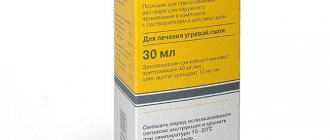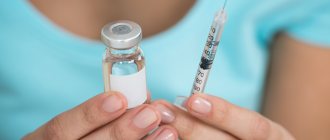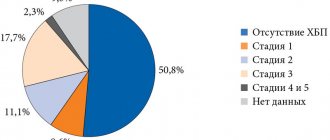Triptorelin-long lyophile d/susp d/im injection prolong 3.75 mg No. 1 + solution
Compound
Active substance: triptorelin acetate 3.92 mg, which corresponds to the content of triptorelin 3.75 mg. Excipients: copolymer of D, L-lactic and glycolic acids (1:1) - 200 mg, D-mannitol - 85 mg, carmellose sodium - 30 mg, polysorbate 80 - 2 mg.
Pharmacokinetics
Absorption After intramuscular administration, a rapid release phase of triptorelin occurs, followed by a continuous release phase (28 days). The maximum concentration is 0.32±0.12 ng/ml. The average amount of triptorelin continuously released is 46.6 ± 7.1 μg/day. Bioavailability after intramuscular administration is about 53% for 1 month. Distribution Triptorelin does not bind to plasma proteins. Cumulation in tissues does not occur. Metabolism The metabolism of triptorelin is unknown. No metabolites were identified. Excretion It is excreted by the liver and kidneys 3 times slower than natural GnRH; the process consists of two phases - fast and slow excretion. Less than 4% of triptorelin unchanged is excreted by the kidneys. Pharmacokinetics in certain groups of patients In patients with impaired renal function, the half-life of triptorelin is 1.4-2.7 times longer than in healthy people. For patients with impaired renal function, adaptation and individualization of triptorelin therapy is not required due to the minor role of the kidneys in the elimination of triptorelin and its wide range of therapeutic effects as an active substance.
Indications for use
- To reduce the size of uterine fibroids in cases of upcoming surgical removal of fibroids or hysterectomy; endometriosis confirmed laparoscopically, if there are indications for suppressing ovarian function and there is no need for surgical intervention.
- Female infertility: ovarian stimulation together with gonadotropins (hMG, hCG, FSH) in in vitro fertilization and embryo transfer programs, as well as other assisted reproductive technologies.
- Symptomatic treatment of hormone-dependent prostate carcinoma.
Contraindications
- Hypersensitivity to triptorelin, other GnRH analogs, components of the drug and solvent;
- condition after previous surgical testiculectomy;
- pregnancy, breastfeeding period;
- children under 18 years of age.
Directions for use and doses
The dosage regimen is individual, depending on the indications, the dosage form used and the treatment regimen.
Storage conditions
Store in a dry place, protected from light, at a temperature of 2-8 C.
special instructions
The side effect is reversible.
Before starting therapy, pregnancy should be completely excluded.
Menstruation usually occurs 3 months after the last injection of the depot form, but in some cases later.
During therapy, the level of sex steroid hormones in plasma (in men and women), as well as the size of fibroids (including using ultrasound), should be regularly monitored. It should be borne in mind that a disproportionately rapid decrease in the volume of the uterus, compared with the size of the fibroids, in some cases can cause bleeding and sepsis.
To prevent overstimulation, follicular growth and the luteal phase should be carefully monitored, especially in polycystic ovary syndrome. During the first month of therapy, women should use non-hormonal contraceptives.
In men, at the beginning of treatment, an increase in plasma testosterone levels is possible, therefore, during the 1st week of therapy, careful monitoring of the patient’s condition and, if necessary, symptomatic therapy are recommended.
Conditions for dispensing from pharmacies
On prescription.
Dosage form
Lyophilisate for the preparation of a suspension for intramuscular administration of prolonged action.
Action
Antitumor.
Pharmacodynamics
Triptorelin is a synthetic decapeptide, an analogue of natural gonadotropin-releasing hormone (GnRH). Replacement of the 6th amino acid residue in the molecule led to a more pronounced affinity for the GnRH receptors and greater metabolic stability and biological activity of triptorelin compared to endogenous GnRH. In the initial period after administration, triptorelin, competitively binding to the receptors of the cells of the anterior pituitary gland, stimulates the secretion of follicle-stimulating hormone (FSH) and luteinizing hormone (LH) by the pituitary gland and, as a result, causes a short-term increase in the concentration of sex hormones in the blood plasma (testosterone in men and estradiol among women). After prolonged stimulation (constant concentration of triptorelin in the blood plasma), the pituitary gland becomes insensitive to the action of GnRH, which leads to a decrease in the concentration of sex hormones in the blood plasma to post-castration or menopausal levels. These effects are reversible after discontinuation of therapy. Therapeutically, this results in a reduction in the growth of testosterone-sensitive prostate tumors in men and a reduction in endometriosis and estrogen-dependent uterine fibroids in women. For uterine fibroids, the greatest benefit from therapy is observed in women with anemia (hemoglobin < 8 g/dL). Suppression of intermediate endogenous peaks of luteinizing hormone makes it possible to improve the quality of folliculogenesis, increasing the number of maturing follicles, and, as a result, increase the likelihood of pregnancy per cycle.
Side effects
From the reproductive system: vaginal dryness, pain during intercourse, weight gain, decreased libido (in women and men), spotting from the vagina, gynecomastia (in men), impotence.
From the central nervous system and peripheral nervous system: rarely - headache, sleep disturbances, depression, fatigue, paresthesia, visual disturbances, back pain, irritability.
From the digestive system: nausea, increased levels of liver enzymes.
Metabolic: increased plasma cholesterol levels, hot flashes with profuse sweating, decreased bone density.
Other: rarely - allergic reactions.
Use during pregnancy and breastfeeding
Contraindicated during pregnancy and lactation (breastfeeding).
Interaction
There have been no controlled clinical studies of the interaction of triptorelin with other drugs.
However, the possibility of interaction of triptorelin with other drugs, including drugs that promote the release of histamine, cannot be ruled out. It is not recommended to prescribe triptorelin simultaneously with drugs that increase the concentration of prolactin in the blood plasma, since these drugs reduce the number of GnRH receptors in the pituitary gland.
It is also necessary to take special precautions and monitor the concentration of sex hormones in the blood plasma when using triptorelin in combination with drugs that affect the secretion of gonadotropins by the pituitary gland.
Long-term androgen deprivation may prolong the QT interval. A risk/benefit assessment should be performed before prescribing triptorelin to patients with congenital long QT syndrome, electrolyte abnormalities, or chronic heart failure; or patients taking drugs that may prolong the QT interval or drugs that may cause torsade de pointes (TdP), such as Class IA (eg, quinidine, procainamide) or Class III antiarrhythmic drugs (eg, amiodarone, sotalol).
Overdose
Cases of triptorelin overdose have not been described. In case of overdose, symptomatic therapy is indicated.
Impact on the ability to drive vehicles and operate machinery
Currently, there is no data on the possible effect of the drug Triptorelin-long on the ability to drive vehicles and operate machinery. However, the use of the drug can lead to the development of such undesirable reactions as headache, decreased vision, drowsiness, which can negatively affect the ability to drive vehicles and perform potentially hazardous activities that require increased concentration and speed of psychomotor reactions. If the symptoms described above occur, you should refrain from driving vehicles and machinery.
It is known that manufacturers, when developing and researching new medicines, are guided mainly by the expected medical effect from the implementation of their inventions. However, in addition to therapeutic effectiveness, there is also the concept of cost-effectiveness. When choosing a specific treatment option, both of these factors must be taken into account, especially in cancer patients.
In the structure of cancer incidence among men in Russia, prostate cancer (PCa) ranks 4th. It is important to note that the incidence of prostate cancer has more than doubled over the past 10 years, and its growth rate is the highest among all cancers in men. Treatment of patients with prostate cancer requires significant budgetary expenditures and more than 50% of the cost of treatment occurs in the last few years of their life, when the bulk of patients receive palliative treatment. The main palliative treatment option for patients with prostate cancer is hormonal therapy.
The purpose of the pharmacoeconomic study was to determine the cost-effectiveness of various options for hormonal therapy for prostate cancer.
Relevance of the topic
Prostate cancer is one of the most common types of cancer in men in Western countries. Treatment options depend on the stage and degree of progression of the disease at diagnosis [1]. For advanced stages of the disease, surgical orchidectomy and hormonal castration are effective palliative treatment options. The most justified method of hormonal castration from the point of view of therapeutic effectiveness is the use of luteinizing hormone-releasing hormone (LHRT) agonists.
Table 1. Prices for drugs (iMs Health Russia, February 2010) in rubles
| trade name | average price | price 1 month treatment | price for 1 year of treatment |
| Zoladex 10.8 mg | 22 959,45 | 7653,1 5 | 91 837,80 |
| Buserelin depot 3.75 mg | 8217,58 | 8217,58 | 98 610,96 |
| Diferelin 3.75 mg | 10 448,32 | 10 448,32 | 125 379,84 |
| Zoladex 3.6 mg | 9266,27 | 9266,27 | 111 195,24 |
| Lucrin depot 3.75 mg | 8696,90 | 8696,90 | 104 362,80 |
| Eligard 7.5 mg | 8488,00 | 8488,00 | 101 856,00 |
| Eligard 22.5 mg | 19 718,00 | 6572,67 | 78 872,00 |
| Eligard 45 mg | 29 660,00 | 4943,33 | 59 320,00 |
| Venlafaxine (average price per pack) | 29,4 | 854 |
Several drugs from the group of LHRT agonists are available in Russia with different efficacy rates and different frequencies of use.
The purpose of this study was to determine how these differences, along with different prices for LHRT agonists, affect the total annual cost of treatment using all three forms of Eligard (1, 3 and 6 months) compared with traditional LHRT agonists (Zoladex 1 and 3 month forms, Buserelin 1 month form, Lucrin depot 1 month form and Diferelin 1 month form). This approach is also known as cost minimization analysis. Materials and methods
In this study, an analytical method using TreeAge® software was used to compare 1-month, 3-month and 6-month formulations. The study followed the same methodology as Odeyemi et al (2007).
The following data were used for analysis in the study:
- the frequency of injections differed for different forms of drugs. All patients in different groups during a year's visit to the doctor received 12 injections (for 1-month forms of drugs), 4 injections (for 3-month forms) and 2 injections (for 6-month forms);
- the number of doctor visits depended on the frequency of injections of the corresponding drug;
- treatment of side effects, primarily hot flashes, was carried out using the drug Venlafaxine;
- the cost of the various drugs listed above was determined based on the average price on the Russian market. The time period for analysis was 12 months;
- the cost of the drugs is shown in Table 1. In addition, the cost of visiting a doctor for an injection of the drug averaged 3,900 rubles per visit (financing standards approved by the Government of the Russian Federation).
Clinical efficacy data were taken from the following multicenter published studies: Eligard: Perez-Marreno, 2003; Chu FM et al., 2002; Crawford et al., 2006; Zoladex: Vogelzang et al., 1995; Lucrin and other forms of leuprorelin: Heyns et al., 2003; Alloul et al., 1998; Buserelin: Alloul et al., 1998.
The following clinical data were used in the study, based on a meta-analysis of existing data and the results of other clinical studies [3, 4, 5, 7, 8]:
- Eligard 7.5, 22.5 and 45 mg are effective in reducing testosterone levels below the traditional 50 ng/dL in almost all patients (98-100%), with the majority of patients (88-98%) even achieving levels of 20 ng /dl or less;
- When using goserelin (Zoladex) for 12 months, 88% of patients achieve testosterone levels <50 ng/dL;
- when using Buserelin for 12 months, 85% of patients achieve testosterone levels <50 ng/dL;
- when using various forms of Leuprorelin after 28 days, 85.2% of patients achieve testosterone levels <20 ng/dl;
- all patients achieve testosterone levels comparable to castration after 12 months of treatment;
- it is assumed that about 2.5% of patients will stop treatment within 1 year, and therefore will receive half the treatment dose compared to patients who complete treatment;
- the only side effect that is taken into account is hot flashes in 0-8% of patients, only 50% of which will require treatment with Venlafaxine 75 mg.
RESULTS
An economic analysis of the annual cost of treatment with various LHRT analogues demonstrated the fundamental influence of two factors: the price of the drug and the frequency of injections. The less often the injections are performed and, accordingly, the less often the patient visits the doctor, the lower the annual cost of treatment (Table 2). For example, over the course of 1 year, 2 injections of a 6-month form of Eligard cost less than 4 injections of a 3-month form of Eligard, which, in turn, will be cheaper than 12 injections of a 1-month form of this drug: 57,184; 76,861 and 100,583 rubles respectively.
The use of the 6-month form of Eligard is associated with a reduction in the number of visits to the doctor by up to 2 during the year, compared with the 3-month form of the drug (saving 7800 rubles) and by 10 visits, compared with the 1-month form (saving 39,000 rubles). Savings of about 39,000 rubles will be observed when comparing the 6-month form of Eligard with any other 1-month form of the LHRT analogue.
Table 2. Average cost of annual treatment with various LHRT analogues
| drugs | annual cost (drugs only) | total annual cost (incl. LPE + Visits) |
| Eligard 6 month old | 57 184 | 61 883 |
| Eligard 3 month old | 76 861 | 85 910 |
| Zoladex 3 month | 90 690 | 99 860 |
| Buserelin 1 month | 97 378 | 1 10 399 |
| Eligard 1 month | 100 583 | 126 625 |
| Lucrin 1 month | 103 058 | 129101 |
| Zoladex 1 month | 109 805 | 135 848 |
| Diferelin 1 month | 1 23 81 3 | 149 853 |
| |* LPE treatment of side effects | | ||
Similarly, 4 injections of a 3-month form of Zoladex cost less than 12 injections of a 1-month form of Zoladex (90,690 and 109,805 rubles, respectively), which is associated with a decrease in the number of visits to the doctor by 8 during the year (savings of 31,200 rubles) .
The results of the study showed that the use of the 6-month form of Eligard is the least expensive type of treatment with a total annual cost of about 61,883 rubles. This is the only 6-month form of the drug in Russia, the use of which is economically justified compared to drugs with more frequent injections.
The 3-month form of Eligard is the second least expensive treatment option (total annual cost is 85,910 rubles), while the cost of using the 3-month form of Zoladex, another 3-month form of the LHRT analogue, reaches 99,860 rubles. In general, the use of 3-month forms of drugs is less expensive than 1-month forms of drugs.
The one-month form of Eligard ranks only 5th in terms of the lowest cost of annual treatment for prostate cancer among the treatment options under consideration (total annual cost 126,625 rubles). However, it is important to note that this is one of the cheapest treatment options compared to other 1-month forms of drugs (the total annual cost ranges from 129,101 to 149,853 rubles).
Budget savings
The study showed that budget savings when switching to the use of the 6-month form of Eligard will amount, on average, to 50,552 rubles per patient during the year, with a range from 24,027 to 87,970 rubles. In other words, budget savings when transferring 1000 patients from existing drugs to the 6-month form of Eligard will exceed 50 million rubles per year or 250 million rubles over 5 years.
Conclusion
The study shows that, taking into account the current prices for drugs from the group of LHRT analogues in Russia, the drug Eligard has a number of advantages compared to other drugs currently on the market. The study was able to prove the following points:
- the use of Eligard 45 mg (6-month form) is a treatment with the greatest cost-effectiveness compared to all other forms of LHRT analogues without any damage to therapeutic effectiveness;
- the minimum cost of using Eligard 45 mg is due to the high effectiveness of therapy, the minimum price of monthly treatment, as well as a decrease in the number of visits by patients to medical institutions (only 2 visits during the year);
- The current price for Eligard 45 mg is optimal in terms of cost/effectiveness ratio, because the overall cost of treatment is reduced when optimal control over tumor progression is achieved;
- The 3-month form of Eligard has a good cost/effectiveness ratio and is in second place in terms of the lowest cost of treatment, in particular, being a cheaper form than the 3-month depot form of Zoladex;
- one-month forms of different drugs of LHRT analogues have comparable costs, but Eligard demonstrates the best cost/effectiveness ratio;
- budget savings when switching to the use of a 6-month form of Eligard amount to, on average, 50,552 rubles per patient per year.
Key words: prostate cancer, pharmacoeconomics, hormonal therapy, LHRT agonists, Eligard. Keywords : prostate cancer, pharma-ernomic aspects, hormone therapy, LHRH agonist, Eligard.
Literature
- Schulman CC Introduction and summary. European Urology Supplements. 2005.4:1-3.
- Odeyemi IAO et al. Economic Impact of different preparations of leprolide acetate in the management of advanced prostate cancer. J Med Econ. 2007. 10:135-146.
- Perez-Marreno R. et al. A six-month, open-label study assessing a new formulation of leuprolide 7.5mg for suppression of estosterone in patients with prostate cancer. Clinical Therapeutics. Nov. 2002. 24 (11): 1902-13.
- Vogelzang NJ et al.. Goserelin versus orchiectomy in the treatment of advanced prostate cancer: final results of a randomized trial. Urology. 1995. 46(2): 220-226.
- Heyns CF et al. Comparative efficacy of triptorelin and leuprolide acetate in men with advanced prostate cancer. BJU International. 2003 92 (3): 226-231.
- Chu F. M. et al. A clinical study of 22.5mg. La-2550: a new subcutaneous depot delivery system for leuprolide acetate for the treatment of prostate cancer. J Urol. 2002. 168(3): 1199-1203.
- Crawford DE et al. A 12-month clinical study of La-2585 (45mg): a new 6-month subcutaneous delivery system for leuprolide acetate for the treatment of prostate cancer. J Urol. 2006. 175 533-536.
- Alloul et al. Meta-analysis and economic evaluation of LHRH agonists' depot formulations in advanced prostatic carcinoma. The Canadian Journal of Urology. 1998. 5 (3): 585-94.
| Attached file | Size |
| Article in PDF format | 699.42 kb |
‹ On the effectiveness of α1-blockers in the correction of dysuria after radiation therapy for prostate cancer Up The use of the prostate peptide complex uroprost in patients with impaired urine outflow from the bladder ›




